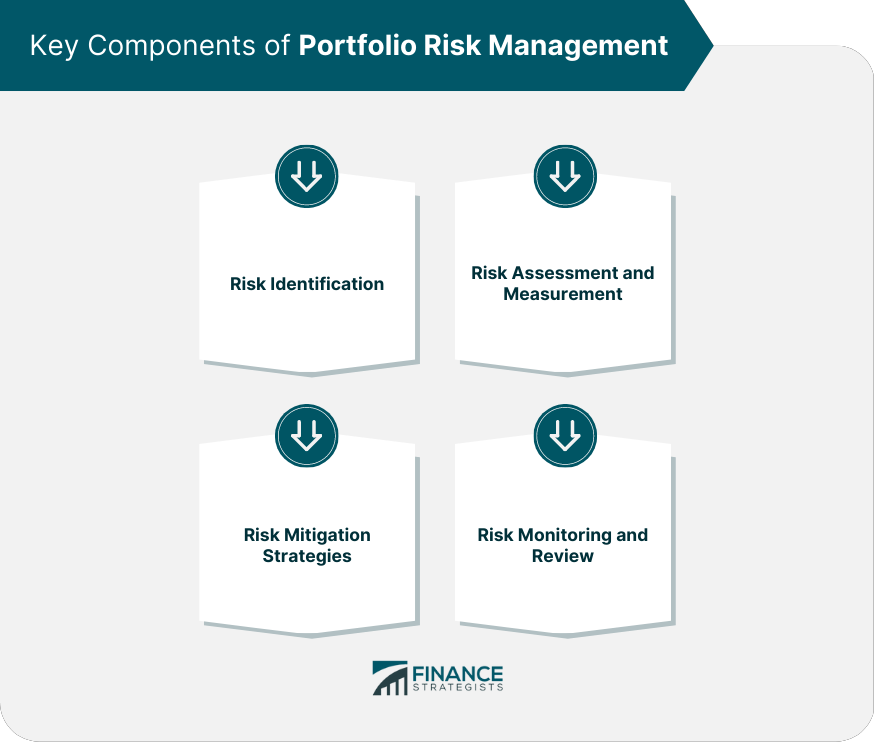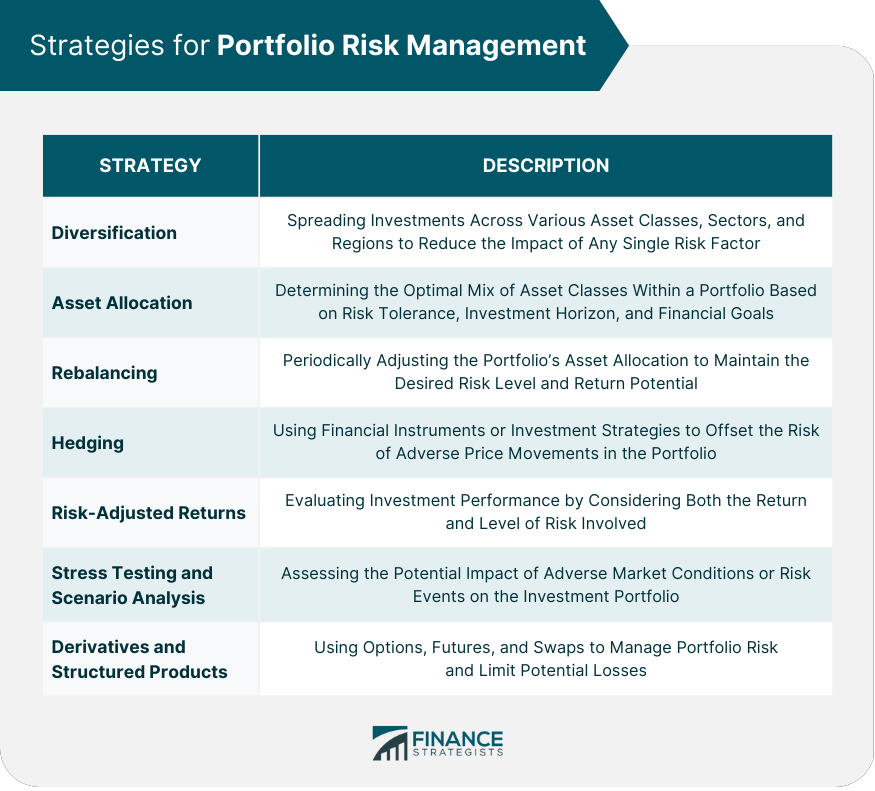Portfolio risk management is the process of identifying, assessing, and mitigating the various risks associated with an investment portfolio. It involves implementing strategies to optimize the balance between risk and return, ensuring that the portfolio aligns with the investor's financial goals and risk tolerance. Managing risk in investment portfolios is crucial to protect and grow investors' wealth. Effective risk management helps minimize potential losses, optimize returns, and improve long-term investment performance. Investors face numerous risks that can impact their investment portfolios, including market risk, credit risk, liquidity risk, operational risk, and other specific risks such as inflation, currency, interest rate, and political risk. Risk identification involves recognizing the various risks associated with an investment portfolio, including those related to specific assets, sectors, or investment strategies. Risk assessment and measurement involve quantifying the potential impact of identified risks on the investment portfolio's performance. This step utilizes various tools and metrics, such as value at risk (VaR), standard deviation, and beta. Risk mitigation strategies involve implementing tactics to reduce the identified risks' potential impact on the portfolio. These strategies may include diversification, asset allocation adjustments, hedging, and rebalancing. Risk monitoring and review involve continuous assessment and evaluation of the portfolio's risk profile and the effectiveness of implemented risk management strategies. Regular portfolio reviews help investors make informed decisions and adjust their strategies as needed. This refers to the risk of a decline in the value of an investments due to factors such as market volatility, economic conditions, geopolitical events, and investor sentiment. For example, a sudden drop in the stock market due to an unexpected economic recession can cause significant losses for equity investors. This refers to the risk of an investment defaulting on its obligations, such as failing to make interest or principal payments. This type of risk is common in investments that involve bonds or other debt securities. This refers to the risk of not being able to buy or sell an investment quickly enough at a fair price. For example, investments in real estate can have high liquidity risks as they may take a long time to sell, and the price may not reflect the fair market value. This refers to the risk of losses caused by human error, technical failures, or other operational issues. For example, a brokerage firm's website going down or a trader making a wrong trade can cause significant operational risks. This refers to the risk of a decline in the purchasing power of an investment due to inflation. Investments that don't keep pace with inflation can result in a decrease in the investor's real returns. This refers to the risk of fluctuations in the exchange rates of currencies. Investments made in foreign currencies can result in gains or losses based on exchange rate movements. This refers to the risk of changes in interest rates, which can affect the value of fixed-income securities such as bonds. For example, when interest rates rise, the value of existing bonds may decrease, resulting in losses for investors. This refers to the risk of losses due to having a large proportion of investments in a single asset, sector, or geographic region. For example, investing heavily in technology stocks can result in significant losses if the sector experiences a downturn. This refers to the risk of losses caused by changes in government policies, geopolitical events, or civil unrest. For example, a sudden change in trade policies can affect the value of investments in affected industries or countries. This refers to the risk of losses caused by changes in regulatory policies or legal challenges. For example, regulatory changes can affect the value of investments in heavily regulated industries such as healthcare or financial services. Diversification involves spreading investments across various asset classes, sectors, and geographic regions to reduce the impact of any single risk factor on the portfolio. Asset allocation is the process of determining the optimal mix of different asset classes within a portfolio based on an investor's risk tolerance, investment horizon, and financial goals. Rebalancing involves adjusting the portfolio's asset allocation periodically to maintain the desired risk level and return potential. Hedging involves using financial instruments, such as derivatives or other investment strategies, to reduce or offset the risk of adverse price movements in the portfolio. Risk-adjusted returns involve evaluating investment performance by considering both the return and the level of risk involved. This approach helps investors compare investments and make informed decisions based on their risk tolerance. Stress testing and scenario analysis involve assessing the potential impact of adverse market conditions or specific risk events on the investment portfolio. This helps investors identify potential vulnerabilities and make adjustments to their risk management strategies. Derivatives and structured products, such as options, futures, and swaps, can be used to manage portfolio risk by providing exposure to specific assets, sectors, or market conditions while limiting potential losses. Risk tolerance is the level of risk an investor is willing to accept in pursuit of their investment goals. It is influenced by factors such as investment horizon, financial goals, and personal temperament. Assessing risk tolerance involves evaluating an investor's financial situation, goals, and preferences to determine the appropriate level of risk for their investment portfolio. Aligning risk tolerance with investment strategy ensures that the portfolio's risk profile is consistent with the investor's goals and preferences, optimizing the balance between risk and return. Periodic portfolio reviews allow investors to evaluate their investment performance and assess the effectiveness of their risk management strategies. Regular reviews help investors determine whether their risk management strategies are effectively mitigating risks and aligning with their financial goals and risk tolerance. As market conditions and risk factors evolve, investors need to adjust their portfolios and risk management strategies to maintain an optimal balance between risk and return. Effective portfolio risk management is essential for investors seeking to optimize their investment performance and achieve their financial goals while minimizing potential losses. Implementing effective risk management strategies can help investors protect their wealth, optimize returns, and improve long-term investment performance. Portfolio risk management is an ongoing process that requires regular evaluation and adjustment to ensure that investment strategies continue to align with investors' financial goals and risk tolerance. By continuously monitoring and managing risk, investors can better navigate the complex world of investing and achieve long-term financial success. Investors may benefit from seeking professional advice from financial advisors or investment managers who can provide expert guidance on risk management strategies and help them navigate the complexities of portfolio management.What Is Portfolio Risk Management?
Key Components of Portfolio Risk Management
Risk Identification
Risk Assessment and Measurement
Risk Mitigation Strategies
Risk Monitoring and Review

Types of Investment Risks
Market Risk
Credit Risk
Liquidity Risk
Operational Risk
Inflation Risk
Currency Risk
Interest Rate Risk
Concentration Risk
Political Risk
Regulatory Risk
Strategies for Portfolio Risk Management
Diversification
Asset Allocation
Rebalancing
Hedging
Risk-Adjusted Returns
Stress Testing and Scenario Analysis
Use of Derivatives and Structured Products

Role of Risk Tolerance in Portfolio Risk Management
Definition of Risk Tolerance
Assessing Risk Tolerance
Aligning Risk Tolerance With Investment Strategy
Importance of Periodic Portfolio Reviews
Evaluating Investment Performance
Assessing the Effectiveness of Risk Management Strategies
Adjusting the Portfolio to Changing Market Conditions and Risk Factors
Conclusion
Portfolio Risk Management FAQs
Portfolio risk management is the process of identifying, analyzing, and mitigating risks associated with an investment portfolio. The aim of portfolio risk management is to minimize losses and maximize returns by understanding and managing the risks associated with different investments.
Portfolio risk management is important because it helps investors avoid losses and make better-informed investment decisions. By analyzing the risks associated with different investments, investors can make informed choices about where to allocate their money and how to diversify their portfolios.
Some common portfolio risk management techniques include diversification, asset allocation, and risk tolerance analysis. Diversification involves spreading investments across different asset classes to reduce risk. Asset allocation involves choosing the right mix of assets based on an investor's goals, risk tolerance, and time horizon. Risk tolerance analysis involves assessing an investor's willingness and ability to take on risk.
Investors can manage risk in a stock portfolio by diversifying their investments across different sectors, industries, and geographic regions. They can also invest in stocks with different market capitalizations and risk profiles. Additionally, investors can use stop-loss orders to limit their losses if a stock's price drops below a certain level.
The role of risk management in portfolio optimization is to balance the potential returns of an investment portfolio against its risks. By identifying and managing risks, investors can optimize their portfolios to achieve their desired level of return while minimizing losses. This involves selecting the right mix of investments, diversifying across different asset classes, and adjusting the portfolio's asset allocation based on changes in market conditions and an investor's risk tolerance.
True Tamplin is a published author, public speaker, CEO of UpDigital, and founder of Finance Strategists.
True is a Certified Educator in Personal Finance (CEPF®), author of The Handy Financial Ratios Guide, a member of the Society for Advancing Business Editing and Writing, contributes to his financial education site, Finance Strategists, and has spoken to various financial communities such as the CFA Institute, as well as university students like his Alma mater, Biola University, where he received a bachelor of science in business and data analytics.
To learn more about True, visit his personal website or view his author profiles on Amazon, Nasdaq and Forbes.















